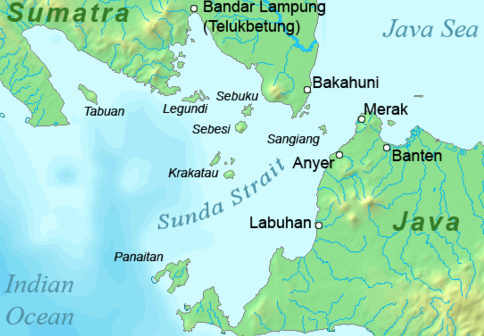Sunda Strait
The Sunda Strait is a strait which is between the Indonesian islands of Sumatra and Java. This strait connects the Java Sea with the Indian Ocean. The name comes from the Sunda Kingdom, a kingdom that rules the western part of Java. It also comes from the name of the Sundanese, the indigenous people of West Java, and the Javanese are found mainly in Central and East Java.
Sunda Strait Geography
The strait runs roughly northeast and southwest with a minimum width of 24 km at its extreme northeast between Cape Pujat in Java and Cape Tua in Sumatra. At its western end it is very deep, but as it narrows to the east it becomes much shallower, with a minimum depth of only 20 m in parts of the eastern end. These shoals have very strong tidal currents, man-made obstacles such as oil rigs off the coast of Java, sandbanks and hence are notoriously difficult to navigate. It was an important shipping route for centuries, especially during the time when the Dutch East India Company used it as a gateway to the Indonesian Spice Islands. However, shallow depth, the narrowness and lack of accurate maps make the strait unsuitable for many large, modern ships, most of which use the Strait of Malacca.
The strait is dotted with several islands, many of which are of volcanic origin. These include Sebesi, Sangiang, Panaitan and Sebuku. The most famous volcano, however, is Krakatoa, which exploded in one of the deadliest and most devastating eruptions in history in the year 1883. The islands of the strait and the nearby surrounding regions of Sumatra and Java were devastated in this eruption, mainly due to the huge tsunamis caused by the collapse of the volcano and intense pumice falls. Some areas, such as the coastal region of Java, which is now incorporated into the Ujung Kulon National Park, have never been relocated, but much of the coast is now very densely populated. Aside from the only remaining peak of Krakatau, Rakata, the Krakatau archipelago consists of the islands of Lang, Verlaten and, more recently, Anak Krakatau, which emerged in the year 1927 from the original remains.


